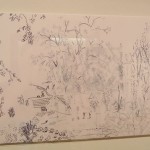Embrace the Ambiguity: Illusion and Immersion
By Shawn Daniell
We live in a world full of ambiguity. Like many people, I find myself having to travel this world with little or no direction. It gets confusing out there trying to interpret the signs, especially when some of those signs may have multiple interpretations. It stands to reason that ambiguity is explored within the arts. Whether you believe it’s the job or role of the artist to explore the real world, you’ll find many that do just that. For some artists that may be in the form of landscapes, still-life, exploring the figure, abstraction, portraiture, and so on. Sometimes the message or imagery is pretty straightforward and easy to understand. And other times our good friend ambiguity rears its mischievous little head. I recently came across this quote by Roger van Oech, a creativity theorist and writer that I felt applied to Rebeca Calderon Pittman’s exhibit, Illusion and Immersion: Rebeca Calderon Pittman’s Recombinant Drawings, on display at Northern Kentucky University’s Third Floor Gallery. “Take advantage of the ambiguity in the world. Look at something and think what else it might be.” Pittman has created images that ask the viewer to do just that. Her artwork asks the viewer to fill in the blank spots, close the gaps, and ultimately collaborate with the artist in the artwork’s completion.
Pittman’s process begins with sketches done by hand of her studio, interior living spaces, and outdoor nature scenes. She then scans each image into her computer and alters them through a digital drawing program. I love the idea of taking what some consider a classical form of creating art and combining it with digital drawing; like combining the hand with the machine. During the digital altering phase, images are layered on top of each other, elements are deleted, and pieces reassembled. These images are then printed onto acetate and layered with sheets of vellum.
At first I was apprehensive. I felt uncomfortable and didn’t know what to think about Pittman’s drawings. But then I began to think about what really troubled me about the pieces. It was their ambiguous nature. To me they felt unfinished and only partially formed. That was until I figured out that the viewer was a key ingredient to the piece. In each image the artist and viewer(s) collaborate together to create new visual spaces. And in these visual worlds I could finally see many themes being explored, such as the notion of space itself and what defines something as a space. Other themes included the idea of exterior versus interior, nature versus man, and the notion of what constitutes a finished artwork. Some of the drawings had layers that seemed to work in harmony with each other, creating peaceful experiences, while other drawings had layers that fought against each other, often creating chaotic and frantic energies. For me, these two conflicting emotions, peace and chaos, reflect the world around us.
Ultimately for me this exhibit was about the ambiguity of life and art. We all bring our own series of experiences to the viewing process, and this affects how we fill in the blanks of each of Pittman’s creations. It’s the ambiguity of each piece that allows multiple interpretations to arise. My visual space may look vastly different from your visual space, but that’s the beauty of ambiguity.
Illusion and Immersion is on display through September 20 at Northern Kentucky University’s Third Floor Gallery in the Fine Arts Center. If you would like more information about these drawings and any other artwork by Pittman, you may visit her website at HYPERLINK “http://www.rebecapittman.com/” http://www.rebecapittman.com/ for more details.
- Anatomy of Sharing
- Bucolic Cogitation
- Solace in Redemption







September 25th, 2013at 3:05 pm(#)
I enjoyed the display of Colderon-Pittman’s drawings very much and agree that your assessment of her work is spot on.
Can’t wit to see what she produces next!